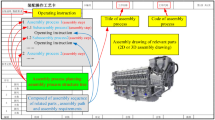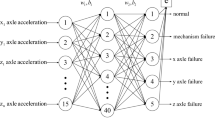In this study, automation of the circuit board assembly process is considered using artificial neural networks with knowledge-based systems. Basic issues in achieving intelligent control that can adapt to changing conditions in the assembly process are discussed. The feasibility of using neural networks for pattern recognition and optimum component insertion sequence generation is examined. The study provides a basic foundation for designing a conceptual architecture for adaptive intelligent control of circuit board assembly. Real-time testing of component recognition is conducted using adaptive resonance theory (ART 1) as a neural network paradigm.
Similar content being viewed by others
References
Ahmadi, R. H. and Kouvelis, P. (1989) Staging problem of a dual delivery pick-and-place machine in a semiconductor manufacturing environment, Working Paper No. 6-9-89.
Aiyer, S. V. B., Niranjan, M. and Fallside, F. (1990) A theoretical investigation into the performance of the Hopfield model, IEEE Transactions on Neural Networks, 1(2),
Bagherzadeh, N., Kerola, T., Leddy, B. and Brice, R. (1987) On parallel execution of the traveling salesman problem on a neural network model, in Proceedings of the IEEE First International Conference on Neural Networks: Vol. III, San Diego, pp. 317–324.
Bao, H. P. (1988) An expert system for SMT printed circuit board design for assembly, Manufacturing Review, 1(4), 275–280.
Beard, R. A. and Rattan, K. S. (1989) Neural network system for robot vision, in IEEE Proceedings of the National Aerospace and Electronics Conference Vol. 4.
Carpenter, G. and Grossberg, S. (1986) Associative learning, adaptive pattern recognition, and cooperative decision making by neural networks, Proceedings of the SPIE, 634, pp. 218–247.
Dagli, H. C., Lammers, S. and Vellanki, M. (1991) Intelligent scheduling in manufacturing using neural networks, The Journal of Neural Network Computing — Technology, Design, and Applications, 2(4), 4–10.
Funk, J. (1989) Design for assembly of electrical products, Manufacturing Review, 2(1), 53–59.
Gavish, B. and Seidmann, A. (1987) Printed circuit boards assembly automation — formulations and algorithms, in Proceedings of the IXth International Conference on Production Research, Cincinnati, Ohio, pp. 662–673.
Hopfield, J. (1984) Neurons with graded response have collective computational properties like those of two-state neurons, Proceedings of the National Academy of Science USA 81, May, pp. 3088–3092.
Hopfield, J. and Tank, D. (1985) Neural computation of decisions in optimization problems, Biological Cybernetics, 52, 141–152.
Naft, J. (1989) Neurocomputing for multiobjective design optimization for printed circuit board component placement, in Proceedings of the International Joint Conference on Neural Networks, pp. 1–503.
Rak, S. and Kolodzy, P. (1988) Invariant object recognition with the adaptive resonance (ART) network, Neural Networks Supplement, INNS Abstracts, 1, 43.
Rockwell, T. H. and Wilhelm, W. E. (1987) Applying cellular structures in small-lot assembly of circuit cards, in Proceedings of the IXth ICPR, Cincinnati, Ohio, pp. 2466–2473.
Simpson, P. K. (1990) Artificial Neural Systems — Foundations, Paradigms, Applications and Implementations, Pergamon Press, New York.
Szu, H. (1988) Fast TSP algorithm based on binary neuron output and analog neuron input using the zero-diagonal interconnect matrix and necessary and sufficient constraints on the permutation matrix, in Proceedings of the IEEE International Conference on Neural Networks: Vol. II, San Diego, pp. 259–266.
Tagliarini, G. and Page, E. (1987) Solving constraint statisfaction problems with neural networks, in Proceedings of the IEEE First International Conference on Neural Networks: Vol. III, San Diego, pp. 741–747.
Xiadong Hu and Carter, M. W. (1989) Optimal component sequencing to minimize total production time (for a single circuit board). Presented at CORS/TIMS/ORSA meeting, Vancouver.
Author information
Authors and Affiliations
Rights and permissions
About this article
Cite this article
Vellanki, M., Dagli, C.H. Artificial neural network approach in printed circuit board assembly. J Intell Manuf 4, 109–119 (1993). https://doi.org/10.1007/BF00124984
Issue Date:
DOI: https://doi.org/10.1007/BF00124984




